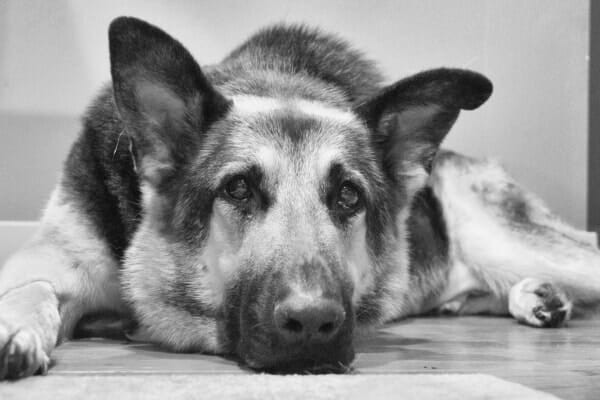
The word “frail” sounds downright dreadful, so when it’s used to describe your beloved senior dog, it’s easy to feel fearful, discouraged, and a tad bit offended. So how exactly does the term apply to senior dogs? Dr. Julie Buzby, integrative veterinarian and founder of Dr. Buzby’s ToeGrips®, welcomes Dr. Susan Davis, a world-renowned animal physiotherapist, to the blog to unpack what frailty syndrome is and what it means for senior dogs and their devoted owners.
You’ve just come from your dog’s annual check-up where your veterinarian mentioned that your dog appears to be “frail.” Before you could form any thoughtful questions about what that meant, the appointment ends and you find yourself helping your grey-muzzled companion into the car. As you drive home the word “frail” plays over and over in your mind. Exactly what does that mean for your dog?
Frailty syndrome in dogs
No question the word conjures up all sorts of images and questions—many of which seem depressing and dire. But hope and help are here! Although it may sound grim, frailty is not a life-threatening problem.
Thanks to advances in veterinary medicine over the past decades, dogs are living longer (to which all dog owners give a hearty cheer!) However, living longer means facing and adapting to challenges similar to those faced by aging humans. For senior dogs, one of those challenges is frailty syndrome.
Before sharing what you can do to help your frail senior friend, let’s talk about the difference between “frail” and “fragile.” We’ll meet two of my four-legged patients who developed frailty syndrome, and learn how vets score the condition. Then, I’ll get ground-level practical about things you can do now to smooth the path forward for your loyal companion.
Fragile vs. frail
First, let’s distinguish between fragile and frail. They are sometimes used interchangeably, but they definitely carry different meanings. Here is my best attempt to explain…
A fragile dog is one that is easily hurt or damaged—think newborn puppy struggling to thrive, a young active dog with open growth plates, or a full-grown dog with a fractured bone.

On the other hand, a frail dog is a dog whose overall body condition is weak. He or she is no longer hardy and has low endurance for daily activity.
Approximately 10% of senior dogs become frail for no other reason than advanced age. In the vast majority of cases, frailty in senior dogs is most often coupled with sickness, surgery, or various types of medication and treatments (like radiation or chemotherapy). This was the case for my friends, Jerz and Sebastian.
Meet Jerz and Sebastian
Jerz, a German Shepherd, and Sebastian, a black and tan Coonhound, both became frail after extensive surgery.
Jerz had pericarditis, an inflammation of the lining around the heart and required surgery to remove it. After surgery, he had a massive surgical incision extending from his breastbone all the way around to his right ribcage. This incision made normal breathing painful and even the simplest of movements a strain. He became weak and fatigued, requiring regular physical therapy. Despite his frailty, the surgery gave him another three years of life.

Sebastian was a strong fellow until he suddenly developed internal bleeding. He had emergency surgery to remove his spleen and a mass in his lower esophagus. After surgery, he developed peritonitis, a life-threatening infection in the abdominal cavity. He bravely battled the complication in the hospital for two weeks and survived.
However, he was now weak and frail with poor endurance. Like Jerz, he became my patient for treatment of frailty issues, and I’m pleased to report, he responded well.
Signs of frailty syndrome in senior dogs
Does your dog have frailty syndrome? Here are some things to look for:
- Your dog looks and acts older than his chronological age.
- Your dog walks very slow and seems unsteady on his feet.
- Your dog’s body appears thin with low muscle tone.
- You notice your dog losing weight or ‘getting smaller as he gets older.’
- Your dog becomes fatigued after a short amount of activity, has low energy levels, and quickly zaps his reserves.
- Your dog gets up very slowly and struggles to move his body (not just the hind limbs but also the entire body).
- Your dog prefers to lie down when he eats and drinks from his food bowls.
- Your dog seems to sleep all the time, especially during the day.
If you see these symptoms, don’t try to diagnose this yourself. The best thing to do is make an appointment with your veterinarian and discuss your observations. It’s entirely possible they may be part of the normal aging process since metabolism and reflexes slow down during the senior years.
Related article: When Is Your Dog Considered a Senior?
Diagnosing and scoring frailty in dogs
If your vet suspects frailty syndrome, he or she may use a simple scoring method physical therapists use in the human field to assess geriatric patients. I have found it to be very useful in veterinary medicine too.
There are five scoring components that form the acronym FRAIL:
F = Fatigue
R = Resistance (meaning the patient is weak and cannot tolerate resistance)
A = Ambulation (meaning walking is difficult)
I = Illness
L = Loss of weight greater than five percent of total body weight
The vet or therapist counts the number of components found in the patient and scores accordingly:
- 0 components = Patient is considered robust
- 1-2 components = Patient is considered pre-frail
- 3-5 components = Patient is considered frail
Now for some good news. In the majority of cases, full or partial reversal of symptoms occurs with physical intervention! When treated properly, a dog often starts to improve in a short period of time.
To help your dog make the most progress, here are a few things not-to-do if your dog has frailty syndrome:
- Never push your dog to the point of fatigue
- Don’t encourage high-intensity exercise like jumping or running
- Stop all deep massage or muscle stretching
- Avoid slippery or steep terrain
8 can-dos for senior dogs with frailty

Here is a list of what you can do for a frail senior dog:
- Apply ToeGrips® dog nail grips if your dog is struggling or slipping on tile or hardwood floors.
- Talk to your veterinarian about proper nutrition and joint supplements for senior dogs. Older dogs benefit from lean proteins, healthy fats, and less grains. Muscle building supplements containing egg yolk protein also might help, but consult your vet before use. (Protein supplements might cause harm in the face of certain concurrent medical conditions, such as kidney disease, cardiac myopathy, diabetes, hepatitis or cancer.)
- Do not neglect your dog’s dental health. Dental disease in dogs leads to nutritional deficiencies and pain.
- Consider a physical therapy evaluation with at-home exercise recommendations. A therapist can evaluate your dog’s posture, weight distribution, mobility, strength, balance, reflexes, and sensation. To find a veterinary rehabilitation practitioner near you, click here and search by state.
- Perform a weekly TUG test. No, this is not tug-of-war, but a Timed Up-and-Go test. Use a stopwatch to time the number of seconds it takes your dog to get up from the floor and walk to the other side of the room. Make a note of it, and use it as a baseline before starting an exercise program. Repeat the TUG test every week to track improvement.
- If your dog has trouble walking use a belly sling or standing harness to assist going outside for bladder and bowel function. In between those times, have your dog stand in place (what we call ‘static standing’) for a minute or two. Increase to five to six minutes several times per day. Place a stack of pillows under your dog’s belly for extra lift and support. If a pool, pond, or lake is available, have your dog stand in shoulder-high water for endurance exercise. After a short time, you will notice your dog standing longer and needing less assistance to walk.
- Use elevated food and water bowls to encourage standing during eating and drinking.
- If your dog is able to walk, even slowly, begin a ‘stand-to-sit’ exercise by holding a treat over the head and giving a command to “sit.” Have your dog repeat stand, sit, stand, sit, etc. for 8 to 10 repetitions. Repeat three times per day.

Love ’em where they are
The very best advice for dealing with senior dog frailty is simply to meet your dog where he is! Accept your dog at whatever stage of frailty he’s in and show him you’re just as faithful to him as he is to you. Gently encourage greater amounts of activity, a little faster or farther each day. That—plus load and loads of hugs, pats, and smiles—will be a winning combination for many years to come.
Do you have experience with a “frail” senior dog?
What have you learned about how to best care for him or her? Share in the comments below.


This was very helpful to me.
Hi Lana,
Thank you for the positive feedback! Best wishes.
Thank you for all the helpful, informative articles. What I’ve learned from my frail older dogs is that maintaining their dignity and feelings of self-worth is very important. When they begin to have accidents, they feel guilty and we may get irritated with the clean-up, especially with large dogs who are difficult to lift and move. To love them best through these trying times, to whichever end, we must check our attitude rather than add to their guilt, and we must help them to stay clean. If we want to keep them with us longer, we must commit to helping them feel like the time is worthwhile. After all they’ve done for us, they deserve that.
Christine, What lovely and true words. I couldn’t have said it better myself. ?